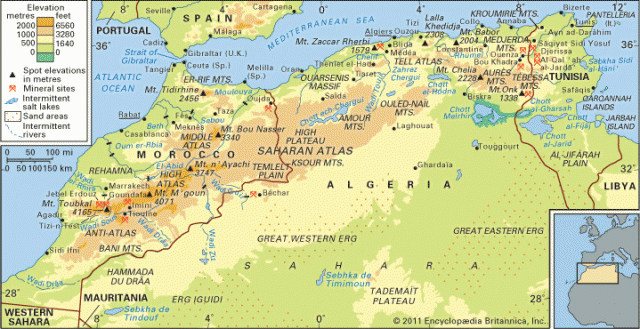Atlas Mountains
THE ATLAS MOUNTAINS of northwest Africa are an elaborate assemblage of mountain ranges that trend from southern coastal MOROCCO and the CANARY ISLANDS, through ALGERIA into coastal TUNISIA. Extending more than 1,500 km (932 mi) and chiefly composed of sedimentary and igneous rocks that have been folded and faulted over the past 85 to 150 million years, the Atlas peaks are a part of the Tethyan Mountain network, an immense mountain group that extends roughly 6,700 mi (11,000 km) and includes the ALPS and Carpathians of Europe, and the CAUCASUS, ZAGROS, Pamir, and the HIMALAYAN mountains of Asia. Furthermore, earthquakes occur regularly along this complex chain, indicating that mountain-building is still taking place.
In Morocco, the Atlas Mountains (“Idrren Dnren” in Berber) consist of four chains: the High, Middle, Anti, and Rif ranges separated by fertile and productive plains. Although the Rif Mountains are traditionally considered not a part of the Atlas system, their uplift epoch, or orogeny, and general trend indicate that they are related. Likewise, although the Middle (Moyen) Atlas are considered a separate range, topographically they are a lower extension of the High (Haute) Atlas complex, where the great Jebel Toubkal rises tallest in the chain at 13,665 ft (4,165 m).

As the mountains bend into Algeria's arid backcountry, the steep peaks flatten into distinctive plateaus. Here, the range has two particular spines: the northern, coastal Tell (or Maritime) Atlas chain and the southern, inland Saharan Atlas Mountains. As they head to the northeast, these ranges encircle the Chott Plateau before consolidating into a single range that follows the coast across Algeria into northern Tunisia.
The Atlas chain also plays an important role in modifying the climate throughout the region. Dividing the mild Atlantic and Mediterranean coasts from the SAHARA DESERT's harsh environment, western and northern slopes receive greater amounts of rain and snow, sustaining numerous farms and orchards along the headwaters of Morocco's and Algeria's ephemeral rivers and wadis (dry riverbeds except in the rainy season). The slopes to the east and south, however, commonly support xeric vegetation like grasses and shrubs and common arid land features like salt pans and dry lake beds influenced from the rains shadow of the mountains.
The Atlas Mountains are also rich in minerals and oil. Phosphate, and metal ores including lead, zinc, copper, silver, manganese are productive commodities, while important coal deposits and petroleum reserves are managed in Morocco, Algeria, and Tunisia. Into the 2000s, as tourism and recreation programs develop throughout the region, the Atlas Mountains are attracting thousands of travelers during the winter each year to ski and trek in the snow, and in the warmer months, tourists can backpack, tour, and hike all across the vast area. The highest peaks of the Atlas Mountains include Jebel Toubkal in the High Atlas Range; Jebel Siroua in the Anti-Atlas Range, 10,843 ft (3,305 m); Jebel Tidiquin in the Rif Mountains, 7,835 ft (2,448 m); Jebel Chelia in Saharan (Aures) Atlas, 7,638 ft (2,328 m).